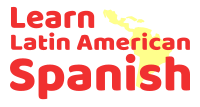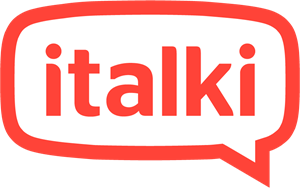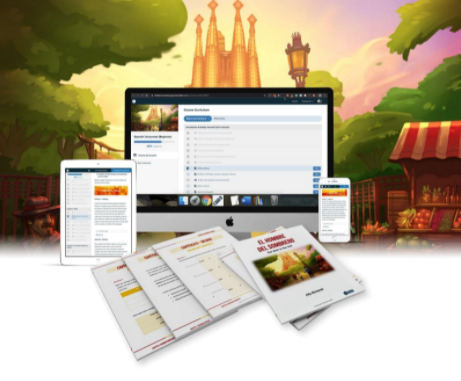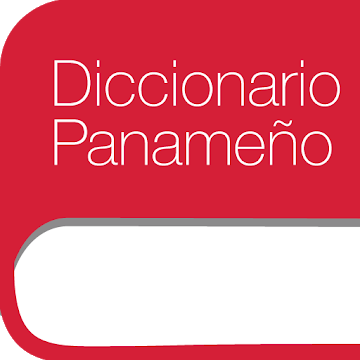|
Panamanian Spanish: A Simple Guide to the Spanish Language of Panama (Audiobook)
This audio guide offers an introduction to the dialect of Spanish spoken in Panama. It includes an overview of the language and culture and lots of words and phrases that can be put to daily use. Topics covered include slang, money, transportation, cuisine, history, and other topics, as well as all the core vocabulary that you would expect from a language course. Learning is split across ten sessions, including learning new vocabulary, pronunciation tips and tricks, cultural sections, and review of content already covered to help make it stick and build fluency. This is an ideal course if you plan to work, retire, or travel in Panama. |
An Overview of Panamanian Spanish
Native speakers: 4 million.
Panamanian Spanish is the Spanish language as spoken in the country of Panama. It is closely related to other varieties of Caribbean Spanish.
The variations among different speaker groups of the same language can be lexical (vocabulary), phonological (pronunciation), morphological (word forms), or in the use of syntax (grammar).
Historically, Panama and Colombia were part of the same political entity. Colombia, governed from the Real Audiencia of Panama during the 16th century, then part of Castilla de Oro, with its capital in Panama, during the 17th century, and after independence from Spain, Panama voluntarily became part of the Republic of Gran Colombia along with Venezuela and Ecuador, with its capital in Bogota. From the colonial times and periods and also during most of the 19th century and until 1903, and even though there are still lexical similarities shared by the two countries (e.g., pelao in both Colombia and Panama means "kid" or "child"), phonetically, Panamanian Spanish is very similar with the Spanish as spoken in the coastal areas around the Caribbean, specifically Cuba, Puerto Rico, the Dominican Republic and the Caribbean coasts of Colombia and Venezuela.
The main characteristic of Caribbean Spanish is the debuccalization of the /s/ sound at the end of a syllable or word, such as in the word cascada, pronounced [kahˈkaða] (like "h" in the English word "he") instead of [kasˈkaða]. The aspiration is also observed in the coastal regions of Peru and Ecuador; in Chile, Argentina, and Uruguay; and in Andalusia and the Canary Islands of Spain.
Another change observed in Panamanian Spanish is the deaffrication of /tʃ/ (as "ch" in the English word "chips") to [ʃ] (as "sh" in the English word "she"), so muchacho is pronounced [muˈʃaʃo], rather than [muˈtʃatʃo]. It is found primarily among less-educated speakers, but it can sometimes be observed among better-educated speakers, as in Andalusian Spanish.
The /x/ is realized as glottal [h], as in Caribbean and other Latin American Spanish dialects, Canarian, and Andalusian Spanish dialects.
Panamanians sometimes use loanwords from English, partly due to the prolonged existence of the Panama Canal Zone. Examples are breaker (from circuit breaker) instead of the Spanish interruptor, switch (from light switch) instead of the Spanish interruptor, fren (from friend) instead of Spanish amigo or amiga (this term is used in a unisex way), ok (from okay) instead of the Spanish vale, and so on. Many of these quotes and phrases are based in the Macaronic language presented in Panamanian slang.
Source: Wikipedia
Panamanian Spanish is the Spanish language as spoken in the country of Panama. It is closely related to other varieties of Caribbean Spanish.
The variations among different speaker groups of the same language can be lexical (vocabulary), phonological (pronunciation), morphological (word forms), or in the use of syntax (grammar).
Historically, Panama and Colombia were part of the same political entity. Colombia, governed from the Real Audiencia of Panama during the 16th century, then part of Castilla de Oro, with its capital in Panama, during the 17th century, and after independence from Spain, Panama voluntarily became part of the Republic of Gran Colombia along with Venezuela and Ecuador, with its capital in Bogota. From the colonial times and periods and also during most of the 19th century and until 1903, and even though there are still lexical similarities shared by the two countries (e.g., pelao in both Colombia and Panama means "kid" or "child"), phonetically, Panamanian Spanish is very similar with the Spanish as spoken in the coastal areas around the Caribbean, specifically Cuba, Puerto Rico, the Dominican Republic and the Caribbean coasts of Colombia and Venezuela.
The main characteristic of Caribbean Spanish is the debuccalization of the /s/ sound at the end of a syllable or word, such as in the word cascada, pronounced [kahˈkaða] (like "h" in the English word "he") instead of [kasˈkaða]. The aspiration is also observed in the coastal regions of Peru and Ecuador; in Chile, Argentina, and Uruguay; and in Andalusia and the Canary Islands of Spain.
Another change observed in Panamanian Spanish is the deaffrication of /tʃ/ (as "ch" in the English word "chips") to [ʃ] (as "sh" in the English word "she"), so muchacho is pronounced [muˈʃaʃo], rather than [muˈtʃatʃo]. It is found primarily among less-educated speakers, but it can sometimes be observed among better-educated speakers, as in Andalusian Spanish.
The /x/ is realized as glottal [h], as in Caribbean and other Latin American Spanish dialects, Canarian, and Andalusian Spanish dialects.
Panamanians sometimes use loanwords from English, partly due to the prolonged existence of the Panama Canal Zone. Examples are breaker (from circuit breaker) instead of the Spanish interruptor, switch (from light switch) instead of the Spanish interruptor, fren (from friend) instead of Spanish amigo or amiga (this term is used in a unisex way), ok (from okay) instead of the Spanish vale, and so on. Many of these quotes and phrases are based in the Macaronic language presented in Panamanian slang.
Source: Wikipedia
Panamanian Spanish Learning Books
|
Panamanian Spanish: Speak like a Native!
Don’t settle for generic Spanish! Put away the stale phrase books and learn to speak just like the natives! Join us as we explore the most common expressions used in Panama. Is a pelaito a small bald person? If someone offers you a camarón, is it seafood or an unexpected opportunity? Discover the real meaning behind the words. You’ll save money at the market and even make new friends. Start learning Spanish…one country at a time. |
|
Panamanian Street Spanish
Whether traveling to Panama as a tourist, student, or with the intention of moving there as an expatriate, this guide will serve you well. You probably already know the Spanish spoken by Panamanians is a unique language, bejeweled with words and phrases never taught in your high school Spanish class. Intended for English speakers, this book shares common Panamanian slang words and phrases to help you communicate in everyday situations like ordering dinner in a restaurant, shopping at the market, flirting in a club, getting street directions, hiring a taxi, and so on. |
|
Diccionario Ilustrado de Panameñismos: En blanco y negro (Spanish Edition)
Panamanian Spanish is the modality of the Spanish language spoken in Panama. It corresponds to a local variant of Caribbean Spanish. On the other hand, Panameñismos (Panamanianism) is defined as the use of the Spanish spoken in Panama. This publication exposes, using various sources, 200 Panamanianisms and includes photographs (captured by the author) to give greater clarity to the subject. In most of the images the author or his closest relatives appear. In others, friends and acquaintances but to which digital effects have been applied to hide their identity. Like other publications, this work is non-profit, whose objective is the creation, promotion, development and promotion of programs, projects and activities that highlight the national identity and cultural heritage of Panama. |
Panamanian Spanish Language Courses
|
1-on-1 Spanish tutoring at italki
One-on-one language tutoring at italki is hands down the most efficient way to reach language fluency. That's why it is the most popular platform today for learning a language online. You can practice conversational skills under different real-world scenarios with a native speaker tutor of your choice who provides you with undivided attention and customized lessons that cater to your learning needs and interests. Whether you’re at home, at the airport, or at your local park, you have complete access to learning Panamanian Spanish or any other language you want with a native speaker from any country of your choice. SPECIAL OFFER: Get $10 italki credits by joining via this link. |
|
Spanish Uncovered: The World’s First StoryLearning Spanish Home Study Course
This new, science-based language learning method was invented by polyglot language expert Olly Richards, who has authored more than a dozen best-selling language books available in bookstores around the world and on Amazon.com. This was the method he used to learn eight languages, and is the exact same method he has been using to help thousands of students learn Spanish. The course comes in both Castilian and Latin American versions, which means that it works for you whatever variety of Spanish you're learning. Find out more! |
|
Baselang's Real World 1-on-1 Spanish tutoring
This top-rated program offers UNLIMITED 1-on-1 Spanish tutoring where you can take as many online Spanish classes as you want, on a daily basis if you wish, with their professional teachers from all around Latin America for a monthly flat rate. Baselang's classes are specifically tailored to your level, from zero to advanced. Don't miss this amazing opportunity! |
|
Preply
Preply is a global online language learning platform designed to promote faster learning with one-on-one online tutors. It connects language tutors with millions of learners from all over the world. You can choose from thousands of Spanish teachers from any country of your choice available in the platform. Book a lesson with a private Spanish teacher today and start learning. Not entirely happy with your tutor? No worries, Preply offers free tutor replacement till you're 100% satisfied. |
Panamanian Spanish Learning Podcasts
|
Podcast on Panama by Lengalia
Listen to native speakers from Panama telling interesting facts about their country, culture and language in Panamanian Spanish accent. |
Panamanian Spanish Learning Blogs
|
16 Panamanian Spanish Slang Words That Only Make Sense In Panama
An excellent blog article on Panamanian Spanish slang by Baselang. With Baselang's UNLIMITED 1-on-1 online Spanish tutoring you can take as many online Spanish classes as you want with their professional teachers for a monthly flat rate. Don't miss the opportunity! |
|
10 Key Panamanian Slang Words to Impress Everyone on the Isthmus
A great blog article on Panamanian Spanish slang by FluentU. |
Panamanian Spanish Learning Apps
|
Diccionario Panameño (Panamanian Dictionary) - On Google Play
This dictionary contains a collection of slang words and expressions typically used in Panama. |
1-on-1 Panamanian Spanish Lessons at italki
|
italki is the most flexible and affordable language learning platform that connects students with the most dedicated teachers around the world for 1-on-1 online language tutoring through video chat. At italki, you can choose an experienced Panamanian Spanish teacher for your personal tutor based on your goals and interests.
Here is a step-by-step instruction to find a native Panamanian Spanish teacher at italki:
Good luck and enjoy your lesson! |
Home | About | Contact Us | Disclosure | Privacy Policy
This page contains affiliate links. For more information, see our disclosure page.
Copyright © 2024 LearnLatinAmericanSpanish.com
This page contains affiliate links. For more information, see our disclosure page.
Copyright © 2024 LearnLatinAmericanSpanish.com


















